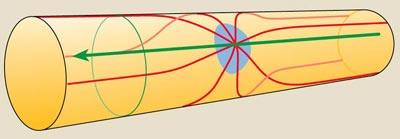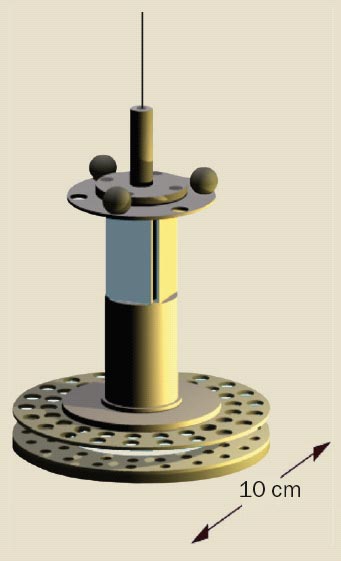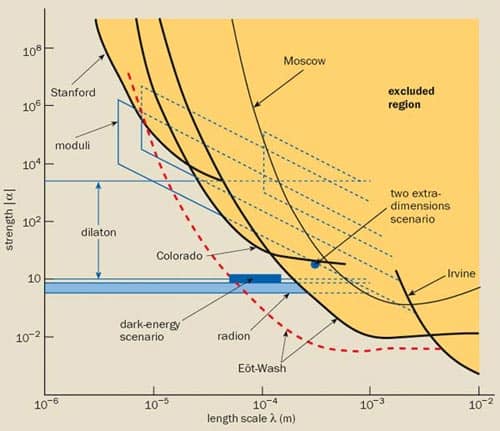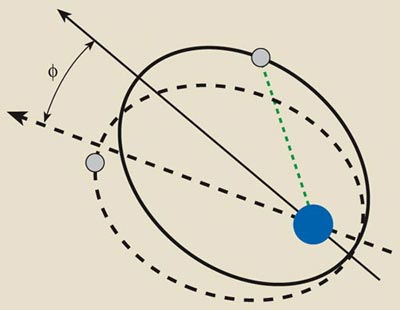If the universe contains more than three spatial dimensions, as many physicists believe, our current laws of gravity should break down at small distances

Nothing seems more certain than the “fact” that there are three dimensions of space. But can we be sure that there are only three dimensions? Imagine a tightrope walker balancing on a cable high above the ground. To the tightrope walker the cable is effectively a 1D object, because he only needs one coordinate to specify his position as he walks back and forth. But an ant, for instance, sees the cable as a 2D object, because it can crawl along and also around the cable.
Today, increasing numbers of physicists are seriously questioning whether we are like tightrope walkers, unaware of the true number of dimensions in space. New ideas from theoretical physics suggest that the best way to discover the actual dimensionality of space is to study how the gravitational attraction between two objects depends on the distance between them.
When Isaac Newton realized that the acceleration of the Moon as it orbited around the Earth could be related to the acceleration of an apple as it fell to the ground, it was the first time that two seemingly unrelated physical phenomena had been “unified”. The quest to unify all the forces of nature is one that still keeps physicists busy today. Newton showed that the gravitational attraction between two point bodies is proportional to the product of their masses and inversely proportional to the square of the distance between them: F = GMm/r2, where F is the force, G is Newton’s gravitational constant, M and m are the masses of the objects, and r is the distance between them.
Newton’s theory, which assumes that the gravitational force acts instantaneously, remained essentially unchallenged for roughly two centuries until Einstein proposed the general theory of relativity in 1915. Einstein’s radical new theory made gravity consistent with the two basic ideas of relativity: the world is 4D – the three directions of space combined with time – and no physical effect can travel faster than light. The theory of general relativity states that gravity is not a force in the usual sense but a consequence of the curvature of this space-time produced by mass or energy. However, in the limit of low velocities and weak gravitational fields, Einstein’s theory still predicts that the gravitational force between two point objects obeys an inverse-square law.
Extra dimensions, fat gravitons and new particles
General relativity has been tested with exquisite precision by astronomical observations, laboratory experiments and various spacecraft (see “Relativity at the centenary” by Clifford M Will in Physics World January pp27-32). Although Einstein’s theory has passed all these tests so far, it is clear that quantum effects will cause general relativity to break down at distances comparable to the Planck length, which is defined as LP = √(h barG/c3)≃ 1.6 x 10-35 m, where h bar is Planck’s constant divided by 2π and c is the speed of light. However, the Planck length is so small that it has no discernable effect in any practical gravitational experiment.
One of the outstanding challenges in physics is to finish what Newton started and achieve the ultimate “grand unification” – to unify gravity with the other three fundamental forces (the electromagnetic force, and the strong and weak nuclear forces) into a single quantum theory. In string theory – one of the leading candidates for an ultimate theory – the fundamental entities of nature are 1D strings and higher-dimensional objects called “branes”, rather than the point-like particles we are familiar with. String theorists seriously entertain the idea that there are actually six or seven additional spatial dimensions; these extra dimensions are needed to make the theory both mathematically consistent and capable of describing gravity.
Of course, these “extra” dimensions must differ from the three infinite dimensions we are familiar with, otherwise we would have noticed them before now. Until recently it was assumed that they were not infinite but curled up with a radius that is comparable to the Planck length. Although this means that the extra dimensions are essentially invisible, their presence prevents the troublesome infinities that plague conventional quantum field theories of gravity.
One of the big puzzles about gravity is the fact that it is so much weaker than the other forces: it is a factor of about 1040 times weaker than the electrostatic and magnetic forces. In 1998 three theorists – Nima Arkani-Hamed, Savas Dimopoulos and Gia Dvali – offered a bold explanation for this weakness (see further reading). Gravity appears weak, they said, because some of the extra dimensions predicted by string theory are surprisingly large compared with the Planck length.
Arkani-Hamed and co-workers argued that we live on a brane with three spatial dimensions that is embedded in a universe containing a total of nine spatial dimensions. All the particles in the Standard Model (including the photon) are strings the ends of which are stuck firmly to the brane. However, the graviton, the particle that is believed to carry the gravitational force, is a closed loop of string and is therefore free to travel throughout all nine spatial dimensions. Gravity appears to be weaker than the other forces because it acts in nine dimensions, not three, and this “dilutes” its strength.
This “brane world” picture implies that we must use gravity if we want to discover the true number of spatial dimensions of our universe. A single, large extra dimension can be ruled out because it would need to have a size of 3 x 1012 m to explain why gravity is so weak. However, Arkani-Hamed and colleagues showed that if two of the extra dimensions were large, they would need to have a size of about 0.3 mm to account for the weakness of gravity. If the researchers are correct, Gauss’s law means that the gravitational force would vary as 1/r4, rather than 1/r2, at distances below 0.3 mm (see figure 1). In other words, gravity would become stronger at short distances.
Last year, however, Raman Sundrum of Johns Hopkins University in Baltimore made a completely different prediction. Sundrum was trying to understand “dark energy”, the mysterious substance that opposes gravity and is thought to be causing the expansion of the universe to accelerate. At first it was thought that quantum-mechanical vacuum energy – due to the creation of short-lived particle-antiparticle pairs, as permitted by Heisenberg’s uncertainty principle – was responsible for the dark energy. The only problem was that theorists predict the value of this vacuum energy to be at least 1060 times larger than the observed value of the dark energy, which has a density of about 4 keV in every cubic centimetre of space.
Sundrum showed that this value, Planck’s constant and the speed of light could be combined to define a length scale of about 0.1 mm, and went on to suggest that the factor of 1060 could be explained if gravity was much weaker at distances shorter than this. He suggested that the graviton in string theory might be a “fat” object that could not “see” most of the short-distance processes that are responsible for the conventional vacuum energy. This would also cause the gravitational interaction to become very weak for masses separated by less than the size of the “fat” graviton (see further reading).
Even without large extra dimensions and fat gravitons, string theories contain many new and as yet unobserved particles. These include the dilaton (which is the partner of the graviton in string theory), the radion (which stabilizes the size of the extra dimensions) and various “moduli” (particles that set the values of coupling strengths, particle masses and other parameters in the Standard Model). The quantum-mechanical exchange of these particles would lead to very strong, short-range forces that could show up in tests of the inverse-square law.
Putting the inverse-square law to the test
It is amazing that, until a few years ago, gravity had not even been shown to exist for objects separated by less than about 1 mm. There were two reasons for this: first, gravity is intrinsically very weak compared with the electrostatic and magnetic forces; second, seismic, thermal and other background effects make the experiments very difficult. Fortunately, electrostatic forces, unlike gravity, can be screened with a conducting shield, and recent experiments with a torsion pendulum have measured the gravitational force between objects separated by less than 65 μm.
Torsion pendulums have been used for over 200 years to measure weak forces between macroscopic objects, and they are still the most sensitive tools for making such measurements. Early versions of the instrument were used to measure the density of the Earth (John Mitchell in 1750), the electrostatic force (Charles Augustin de Coulomb, 1785) and G (Henry Cavendish, 1798). Later, in 1890, Baron von Eötvos used a torsion pendulum to test the equivalence of gravitational mass (i.e. the m in F = GMm/r2) and inertial mass (the m in F = ma). And today, modern versions of the torsion pendulum are being used in a variety of experiments, including high-precision measurements of G and tests of Lorentz symmetry (see “Breaking Lorentz symmetry” by Robert Bluhm in Physics World March 2004 pp41-46). A torsion pendulum has also been used to verify that “dark matter” obeys the equivalence principle.
Although modern torsion pendulums take many different forms that the physicist of 200 years ago would not recognize, the basic principles have remained essentially unchanged (see box). In a traditional torsion pendulum the gravitational force between two test masses suspended on a fibre (the pendulum) and two fixed masses (the attractor) causes the fibre to twist by an amount that depends on the force. This twist is typically measured by reflecting a beam of light from a mirror on the pendulum.
Ironically, the instrument is suited to gravitational measurements because the rotational motion of the pendulum about the torsion-fibre axis is not sensitive to the Earth’s gravity. Moreover, it is insensitive to net forces acting on its centre of mass, which means that it can be substantially decoupled from external fluctuations, most of which are much larger than the effects of interest.
Modern torsion pendulums are sensitive to torques as small as 10-18N m. Since torque is defined as the product of a force and a length, and a typical length in a pendulum is about 1 cm, this is equivalent to a force sensitivity of about 10-16 N. This remarkably small force is roughly equivalent to 1/100th of the weight of a single piece of a postage stamp that has been divided into a trillion equal pieces! To date, the torsion pendulum is the only instrument that is capable of precisely measuring the properties of the gravitational interaction at length scales below 1 mm.
Since the mid-1980s, groups at the University of California at Irvine, Moscow State University and the present authors and colleagues in the Eöt-Wash group at the University of Washington in Seattle have been using torsion pendulums to perform ever-more-sensitive tests of the inverse-square law at short distances. If the inverse-square law holds, the gravitational potential energy of a pair of point masses can be written as: V = -GMm/r. Researchers generally look for a new force that violates Newton’s inverse-square law with a characteristic length scale: this involves looking for a potential of the form V = -(GMm/r)(1 + αe-r/λ), where α is a measure of the strength of the new force and λ is its range. This new “Yukawa potential” generally describes a short-range force that would be carried by a particle with a mass of h bar/cλ, and it is a good approximation to the effects of extra dimensions until separations become smaller than the size of those dimensions.
Measurements at separations as small as 0.14 mm by our group in Seattle have already ruled out the original scenario of Arkani-Hamed and co-workers for two large extra dimensions, and recent preliminary results show that any extra dimension must be smaller than about 60 μm (see figure 2).
The minimum separation between the pendulum and the attractor in this experiment – the most important experimental parameter – was limited by seismic vibrations, occasional dust particles and alignment uncertainties. Future efforts will probe gravity with separations of less than about 50 μm – a distance corresponding to roughly half the diameter of a human hair!
Smaller and smaller
Promising new techniques involving small oscillators and microcantilevers are also being introduced to search for new physics hidden in the behaviour of gravity over short distances. Although these devices have not yet achieved the sensitivity of torsion pendulums, modern fabrication techniques allow them to be much smaller and stiffer. This suppresses the problems associated with seismic noise and alignment, and allows much smaller separations of the test masses to be explored.
In 2003 John Price and co-workers at the University of Colorado in Boulder reported the first results from a torsion-oscillator experiment in which the test mass is a tungsten wafer, approximately 0.2 mm thick, that twists about a horizontal axis, and the source mass is a tungsten cantilever with dimensions 35 x 7 x 0.3 mm. The cantilever sits below the wafer on one side of the twist axis and the separation between the two masses is about 0.1 mm. The device is driven at the resonant frequency of one of the torsional modes of the wafer, which is about 1 kHz (compared with about 1 mHz for a torsion pendulum), and the response of the test-mass wafer on the other side of the twist axis is observed using capacitive techniques (see Long et al. in further reading).
The use of flat sheets for the test and source masses makes the Newtonian background in this experiment very small, so the detection of a spurious excitation at the resonant frequency could signify the existence of a new short-range effect. Although this device is not yet sensitive enough to detect gravity itself, it could detect new forces that are stronger than gravity at small distances, and the sensitivity should improve in the near future to the level needed to probe gravity directly at very small distances.
Meanwhile, Stephan Schiller and co-workers at the University of Dusseldorf in Germany have built a rotating-wheel attractor mass that resembles the one used in the Eöt-Wash torsion pendulum, while their detector resembles the wafer used in the Colorado experiment. New results from this group will be reported in the near future.
Elsewhere, Aharon Kapitulnik and co-workers at Stanford University have used semiconductor fabrication techniques to make microcantilever devices that sense the force between the masses directly, rather than measuring the torque (see Chiaverini et al. in further reading and figure 3). Their first results, obtained at a separation of only 25 μm, provide the most sensitive limits on any such forces at a range of distances below 10 μm. The Stanford group is currently developing a modified apparatus that will have a dramatically increased sensitivity.
Testing gravity with neutrons
Torsion pendulums and other mechanical oscillators have achieved the best sensitivity to short-distance gravity because they contain enormous numbers of atoms and the gravitational signal grows roughly as the square of the number of atoms. However, it is also possible, in principle, to probe the behaviour of gravity at short distances with single particles or small groups of particles. Most of these experiments have been carried out with neutrons because, being neutral, they do not experience significant electric forces caused by background fields or surfaces.
In 2001 Valery Nesvizhevsky and co-workers at the Institut Laue-Langevin neutron source in Grenoble, France, pointed a highly collimated beam of ultracold neutrons at the surface of a horizontal polished glass plate at a grazing angle. The neutrons travelled so slowly (less than 5 m s-1) that they were reflected by the potential-energy barrier associated with the strong nuclear force at the surface. The combined effect of gravity (acting downwards) and the surface (acting upwards) created a 1D potential well – qualitatively familiar to all physicists from their first lectures in quantum mechanics – in the vertical direction.
Nesvizhevsky and co-workers placed a neutron absorber above the plate and counted the number of neutrons that bounced off the surface and reached a detector on the far side as they moved the absorber up and down. They found that the number of neutrons increased significantly when the distance between the plate and the absorber became larger than the height of the quantum ground state of the gravitational potential well, and that it increased again when the absorber was raised above the height of the first excited state. This was the first time that quantum states had been observed in the Earth’s gravitational field.
Although this and subsequent experiments have not been sensitive enough to detect variations from the inverse-square law, Nesvizhevsky and co-workers have been able to place upper limits on new forces that are very much stronger than gravity for distances between 1 nm and 1 μm (see further reading). Such a force would change the potential well and therefore modify the vertical distribution of the neutrons.
Tests at astronomical distances
Although most attention has focused on the behaviour of gravity at short distances, it is possible that tiny deviations from the inverse-square law occur at much larger distances. In 2003 Dvali, who is now at New York University, and two colleagues, Andrei Gruzinov and Mattias Zaldarriaga, explored the possibility that non-compact extra dimensions could produce such deviations at astronomical distances (see further reading).
By far the most stringent constraints on a test of the inverse-square law to date come from amazingly precise measurements of the Moon’s orbit about the Earth. However, this marvellous sensitivity is obtained for values of the order of the Earth-Moon separation. These experiments involve reflecting laser beams off retroreflector arrays placed on the Moon by the Apollo astronauts and by an unmanned Soviet lander. Even though the Moon’s orbit has a mean radius of 384,000 km, the models agree with the data at the level of 4 mm!
The observable that is best suited to testing the inverse-square law in this system is the precession of the major axis of the Moon’s orbit (see figure 4). According to classical mechanics, the major axis should not precess at all in the presence of a 1/r2 gravitational interaction. Indeed, it was a major triumph for general relativity when Einstein was able to explain the previously mysterious precession of the major axis of Mercury’s orbit by 420 milliarcseconds per year.
When the effects of general relativity and the influence of the Sun and the other planets are included, the predicted value for the precession of the Moon’s orbit (19 milliarcseconds per year) is in very good agreement with the measurements, and any discrepancy caused by a possible breakdown of the inverse-square law must be less than 270 microarcseconds per year. However, if we could measure the Moon’s orbit even more accurately, we might be able to detect small deviations from the inverse-square law at large distances that some theorists have predicted.
Tom Murphy of the University of California at San Diego and colleagues at Harvard University and the University of Washington have recently started a new lunar laser-ranging programme called APOLLO that will use a larger telescope at a better location (a mountain top near White Sands in New Mexico) and a more sophisticated photon detector in order to improve the precision of these measurements by a factor of 10. Instead of receiving about one reflected photon for every 100 laser shots, APOLLO should count several photons per shot (see Physics World June 2004 p9).
What if the inverse-square law breaks down?
Suppose that the next generation of experiments detects a force between two test objects that differs from what one would expect from conventional gravity. The discrepancy might be a new property of gravity itself, such as an extra spatial dimension or a large graviton, or it may be due to a new interaction that acts in addition to gravity. How might one distinguish between these possibilities?
The first step would be to see if the size of the discrepancy depended on the composition of the test objects. Gravity has the unique property that it couples equally to all materials, so that all objects, regardless of their composition, fall at the same rate in a uniform gravitational field. This is a consequence of the equivalence between gravity and acceleration, which is the fundamental principle on which Einstein based the general theory of relativity. Any new non-gravitational force will couple differently to different materials, so if we find that the deviation from the inverse-square law depends on composition, we can rule out extra dimensions as the origin of the effect. It would also be important to measure how any deviations changed with distance.
The explosion of ideas in recent years about new particles and new dimensions has reshaped the way we think about our universe. The discovery of dark energy also confirmed that there is a lot that we do not understand. Were Einstein still alive, he would certainly be curious to know if we were walking on a tightrope.








